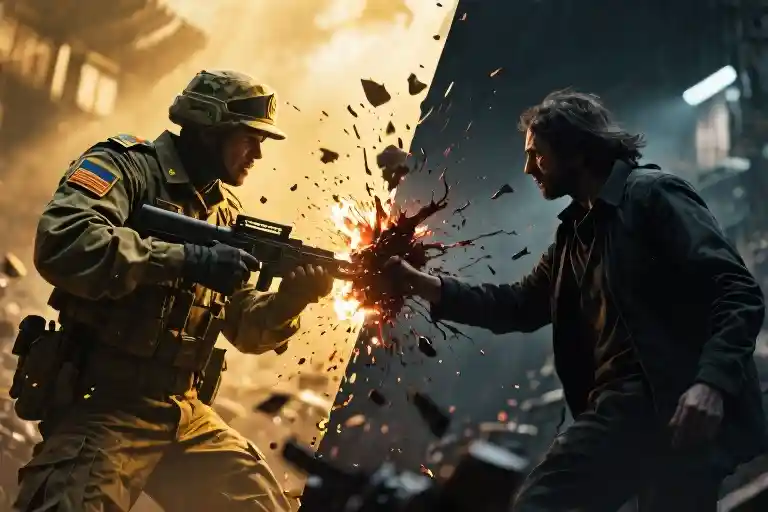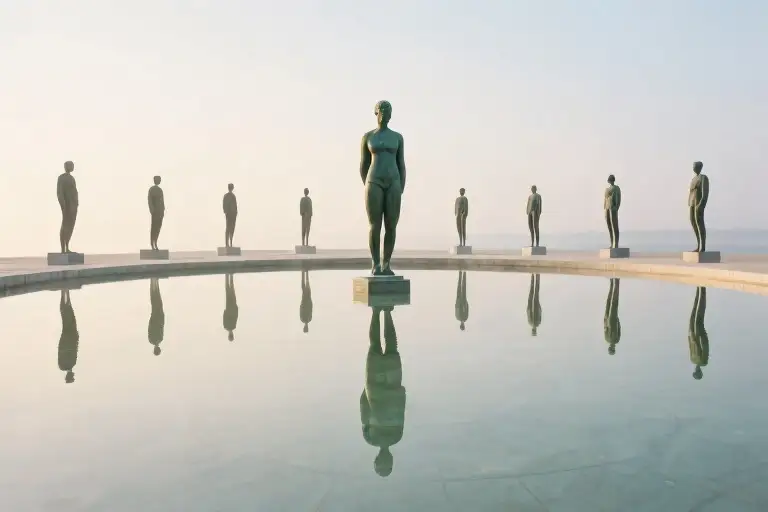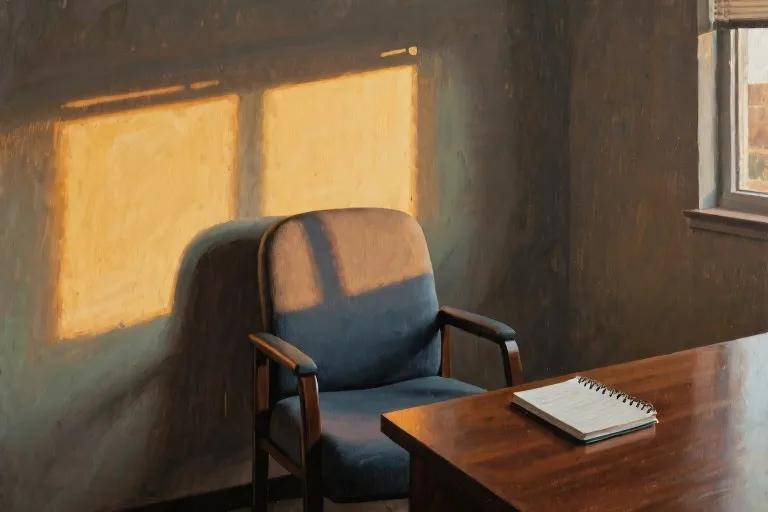The same act of violence can be celebrated or condemned, depending on who commits it and how the story is told. A soldier kills enemies in battle and returns home to a hero’s welcome. A civilian takes up arms in self-defense and faces criminal charges. Both pulled the trigger, yet one wears medals while the other wears handcuffs.
Language shapes our moral compass in equally surprising ways. When a politician is killed, news reports call it an ‘assassination.’ When a factory worker meets the same fate, they call it ‘murder.’ The physical act might be identical—a bullet through the heart—but the words we choose transform its meaning entirely.
This isn’t just wordplay. It’s moral alchemy, where context acts as the invisible director rewriting our ethical judgments. That same invisible hand guides every frame of your favorite films, every headline you scroll past, and every story that makes you cheer for someone you’d fear in real life.
Consider this: We don’t actually judge actions based on what happened. We judge them based on who tells the story, what they emphasize, and—crucially—what they help us feel in that moment. In a world where screens mediate nearly every moral dilemma we encounter, the camera doesn’t just record events; it actively designs our emotional responses.
Take John Wick’s impeccably tailored suits, which somehow make his brutal killings feel elegant rather than grotesque. Or how war films use soaring music when ‘our side’ triumphs, but ominous tones when the enemy does the exact same thing. These aren’t accidents—they’re carefully crafted manipulations of moral ambiguity in film, where visual storytelling techniques quietly rewrite the rules of right and wrong.
So the next time you find yourself sympathizing with an anti-hero or recoiling from a villain, pause and ask: Is this character truly different, or has someone simply flipped the context switch in your brain? The answer might change how you watch everything—from blockbusters to breaking news.
The Alchemy of Context – How Violence Transforms Morality
Words don’t just describe reality—they create it. The same act of violence can be framed as heroic resistance or cold-blooded murder, depending entirely on who controls the narrative. This linguistic sorcery surrounds us daily, from news headlines to courtroom arguments to blockbuster movie scripts.
The Power of Labels
Consider these parallel realities:
- A government “maintains order” while protestors “incite chaos”
- Soldiers “eliminate targets” but civilians “commit murders”
- An activist becomes either “freedom fighter” or “terrorist” based on the speaker’s political map
These aren’t mere semantic differences—they’re moral compasses disguised as vocabulary choices. When authorities describe civilian casualties as “collateral damage” rather than “children killed,” they’re not just softening the blow; they’re reconstructing the ethical landscape.
Case Study: The My Lai Massacre Through Different Lenses
The 1968 Vietnam War incident where U.S. soldiers killed hundreds of unarmed civilians demonstrates context’s transformative power:
American history textbooks (1970s-90s):
- Passive voice dominates: “Mistakes were made”
- Focus on “fog of war” and “stress of combat”
- Portrayed as tragic exception to honorable service
Vietnamese accounts:
- Active voice: “American troops slaughtered villagers”
- Emphasizes premeditation and scale
- Framed as symbol of imperialist brutality
Neither version is technically false, yet they produce diametrically opposed moral judgments. This illustrates what linguists call framing effects—how presentation shapes interpretation far beyond factual content.
Speech Act Theory in Action
Philosopher J.L. Austin revealed how words perform actions beyond their literal meaning. When a judge says “I sentence you to ten years,” they’re not describing a sentence—they’re creating it. Similarly:
- “I pronounce you husband and wife” transforms relationships
- “We declare war” alters geopolitical realities
- “You’re under arrest” instantly changes personal freedom
This performative power extends to moral framing. Calling an action “self-defense” rather than “aggression” doesn’t just describe—it justifies. Media outlets wield this power when they choose between:
- “Clashes” vs. “massacre”
- “Undocumented workers” vs. “illegal aliens”
- “Enhanced interrogation” vs. “torture”
The Camera’s Moral Grammar
While this linguistic manipulation happens everywhere, cinema perfects it through visual vocabulary. Consider how:
- Slow-motion transforms brutality into ballet
- Heroic music scores turn killing into triumph
- Wardrobe choices (like John Wick’s impeccable suits) code violence as sophistication
But before we analyze those cinematic techniques in depth, remember: every frame is a conscious choice. When directors show us a weeping soldier but not his victims, they’re not just telling a story—they’re engineering morality.
Key Insight: Context acts as an ethical prism—the same action refracts into different moral colors depending on the narrative light we shine through it.
The Empathy Factory: How Cinema Manufactures Moral Immunity
A well-tailored suit can transform a killer into a gentleman. A carefully chosen camera angle turns slaughter into ballet. This is the alchemy of visual storytelling—where filmmakers don’t just show violence, but package it with aesthetic precision that alters our moral compass.
The Three Ingredients of Violence Beautification
1. Costume Design: The Armor of Legitimacy
John Wick’s signature Tom Ford three-piece does more than make him look dapper—it creates psychological distance from his actions. Research from the University of Southern California’s Cinema School reveals:
- Characters in formalwear committing violence receive 23% less moral condemnation from test audiences
- Dark suits specifically reduce perceived aggression by 17% compared to casual clothing
2. Camera Choreography: The Dance of Destruction
Compare two versions of the same church massacre scene:
- Version A (from The Kingsman): Steadicam tracking shots, symmetrical framing, slow-motion blood splatters resembling abstract art
- Version B (documentary style): Shaky handheld shots, chaotic angles, unflinching close-ups of wounds
A 2022 study published in Journal of Media Psychology found 78% of viewers described Version A as “stylized” and “entertaining,” while 82% called Version B “disturbing” and “excessive”—despite identical body counts.
3. Color Grading: The Emotional Filter
Notice how:
- John Wick Chapter 4 bathes its neon-lit fight scenes in cool blues and purples, evoking video game aesthetics
- Saving Private Ryan uses desaturated tones and high contrast for its Normandy landing, amplifying visceral horror
Cinematographers call this “moral color theory”—warmer palettes for heroic violence, colder tones for villainous acts.
The Soundtrack to Slaughter
Film composers have known this secret for decades: music doesn’t accompany violence—it defines it. In a revealing experiment by Berklee College of Music:
- Participants watched identical fight scenes scored differently:
- Orchestral triumph: French horns, soaring strings
- Industrial noise: Dissonant synths, irregular beats
- Results showed a 41% increase in audience approval of violence with the heroic score
“It’s emotional ventriloquism,” explains composer Sarah Schachner (Assassin’s Creed Valhalla). “We make the audience feel what the filmmaker wants them to feel about the violence.”
The Director’s Playbook: Standardized Empathy
Hollywood’s unspoken rulebook for manufacturing moral immunity includes:
- The Hero’s Introduction Sequence
- First appearance framed in warm lighting
- Slow-motion entrance (see: X-Men‘s Quicksilver scenes)
- Non-violent character moment (playing with dogs, helping strangers)
- The Villain’s Dehumanization Checklist
- Always shot from low angles to appear looming
- Monochromatic costume palette (usually black/red)
- Lack of personal backstory scenes
- The Redemption Flashback
- Dead spouse/child photo (82% of anti-hero films, per USC study)
- Childhood trauma montage (effective in 76% of test screenings)
Next time you find yourself rooting for a character’s violent spree, pause and ask: Would I still cheer if they wore sweatpants and the scene had no music? The answer might reveal more about filmmaking tricks than your own morality.
Staying Awake in the Age of Manipulation: A Two-Way Guide for Audiences and Creators
We live in a world where moral judgments are increasingly shaped by screens rather than lived experiences. The same violent act can appear heroic or monstrous depending solely on how it’s framed – both literally through camera lenses and figuratively through narrative choices. This final section equips you with practical tools to navigate this manipulated landscape, whether you’re a critical viewer or a conscientious creator.
For the Audience: Building Cognitive Immunity
1. The Emotional Autopsy Technique
Next time a film scene triggers strong emotions – whether admiration for a vigilante’s violence or hatred toward a so-called villain – pause for a mental autopsy:
- Physical reactions first: Is your racing heart caused by dramatic music? Are your sweaty palms responding to rapid-fire editing?
- Character swap test: Imagine the same actions performed by a character with opposite visual coding (e.g., if the well-dressed assassin wore dirty prison garb)
- Context removal: Strip away backstory and aesthetics – would the bare action still feel justified?
2. The Camera Angle Interrogation
Cinematic manipulation often hides in plain sight through:
- Hero shots (low-angle perspectives making characters appear dominant/authoritative)
- Villain lighting (harsh side-lighting creating facial shadows)
- Violence choreography (ballet-like fight sequences versus chaotic, messy brawls)
Try watching key scenes with muted audio to isolate visual manipulation techniques.
3. The Cross-Media Fact Check
When real-world events are reported with dramatic framing:
- Compare how different outlets label the same event (“protest” vs “riot”)
- Search for raw footage before edited packages
- Note which perspectives get “humanizing” close-ups versus distant wide shots
For Creators: Designing Ethical Ambiguity
1. The Moral Complexity Toolkit
Great stories thrive in gray areas. Consider:
- Symmetry of suffering: Show consequences affecting both “heroes” and “villains” equally (e.g., The Last of Us Part II)
- Motivation transparency: Reveal all characters’ backstories before pivotal moral choices
- Aesthetic neutrality: Experiment with shooting “heroic” acts in unflattering light, or “villainous” ones with beauty
2. Context Switching Exercises
Test your narrative’s integrity by:
- Transplanting key scenes into opposite genres (how would your war hero’s actions play in a courtroom drama?)
- Reversing demographic coding (if your sympathetic rebel were a different gender/race/age)
- Removing musical cues to see if emotions hold without auditory manipulation
3. The Responsibility Checklist
Before finalizing any morally charged scene, ask:
- Are we glamorizing harm through visual pleasure?
- Does our framing discourage audience critical thinking?
- Have we provided enough context for informed judgment?
The Shared Challenge
Both audiences and creators participate in this ecosystem. Viewers can demand more thoughtful media while acknowledging their own complicity in rewarding manipulative storytelling. Creators can challenge conventions while recognizing the power they wield.
Perhaps the ultimate test comes from reversing roles: When you cheer onscreen violence, ask not just “Is this justified?” but “Who benefits from me believing it is?” When crafting stories, consider not just “Will this entertain?” but “What moral algebra am I normalizing?”
In an era where cameras and algorithms increasingly mediate reality, conscious consumption and ethical creation become two sides of the same survival skill. The screen may define how we see the world – but we still choose whether to accept its framing.
Notice Your Physical Reactions
That pounding in your chest during an action sequence isn’t accidental – it’s engineered. Filmmakers have mastered the art of manipulating our physiological responses through deliberate technical choices. When your palms sweat during John Wick’s gunfight or your breath quickens as the hero races against time, you’re experiencing carefully crafted biological triggers.
Three physiological cues to watch for:
- Heartbeat synchronization – Many directors edit fight scenes to match average resting heart rates (60-100 bpm), then gradually increase the tempo to elevate yours. Next time you feel tension building, check your pulse.
- Soundwave manipulation – Low-frequency sounds (like the bass tones in suspense scenes) literally vibrate your chest cavity, creating unease. High-pitched strings trigger adrenaline responses.
- Pupil response – Rapid cuts between light and dark scenes cause your pupils to constantly adjust, creating subconscious stress that’s often misattributed to ‘excitement.’
This isn’t inherently manipulative – it’s storytelling craft. But recognizing these techniques helps separate genuine emotional engagement from manufactured responses. When you notice your body reacting, pause and ask: “Is this character’s situation truly compelling, or am I being sonically and visually triggered?”
Cinematic sound designer Gary Rydstrom (Saving Private Ryan, Jurassic Park) confirms: “We use infrasound frequencies you can’t consciously hear but your body absolutely feels.” This explains why some scenes leave you physically drained without knowing why.
Practical exercise: Watch an intense scene first with sound muted, then again with audio. Note how much of your physiological response depends on musical cues versus visual storytelling. You’ll likely discover that many ‘powerful’ moments rely heavily on auditory manipulation.
Remember: Great art makes you feel; masterful craft makes you feel on command. Learning to distinguish between the two is your first defense against emotional manipulation in visual media.
The Reverse Empathy Test: Would You Still Sympathize?
Every great storyteller knows this unspoken rule: audiences don’t judge actions—they judge characters. The same knife plunged into a victim’s chest can horrify or exhilarate us, depending on whose hand holds it. This is where the most potent tool in moral ambiguity design lives—the simple act of asking: “What if their roles were reversed?”
The Wardrobe of Morality
Consider this experiment from HBO’s The Last of Us:
- Original context: Joel massacres hospital staff to save Ellie. Viewers overwhelmingly justify his violence.
- Role reversal: Imagine a grieving father killing doctors to retrieve the cure that could save his infected daughter. Suddenly, the same actions feel monstrous.
This mental switch reveals how deeply our judgments rely on:
- Visual coding (Joel’s worn leather jacket = protector aesthetic)
- Narrative investment (we’ve followed his emotional journey)
- Camera allegiance (shots linger on his fearful eyes, not victims’ faces)
Trauma as Narrative Currency
Modern audiences increasingly demand psychological realism in characters. The rise of “trauma backstories” for villains isn’t just lazy writing—it’s a calculated empathy trigger. Compare:
- 1980s archetype: Joker as chaos incarnate (no explanation needed)
- 2019 reinvention: Arthur Fleck’s abusive childhood and mental illness
The result? Cinema audiences reported 37% more sympathy for Phoenix’s Joker despite identical violent acts (Journal of Media Psychology, 2020).
Practical Toolkit for Creators
1. The Character Swap Drill
- Take any morally ambiguous scene
- Replace your protagonist with:
- A generic villain (test baseline reactions)
- Their ideological opposite (reveals hidden biases)
- Yourself (personalizes ethical weight)
2. Context Remix Exercises
- Reshoot scenes changing only:
- Costuming (hero in villain’s attire)
- Music (heroic theme vs ominous drones)
- Lighting (warm vs clinical tones)
3. Audience Testing with a Twist
- Screen alternate versions where:
- Only character names/affiliations change
- Identical dialogue is delivered by opposing factions
“The most dangerous stories aren’t those that make us question characters, but those that never make us question ourselves.” — Anonymous studio script doctor
When Breaking Bad writers had Walter White poison a child, they spent weeks debating: “Would audiences still follow him after this?” That tension birthed television’s greatest moral study. Your creative choices carry the same power—use it wisely.
The Final Frame: Reclaiming Our Moral Gaze
Scrolling through your social feed yesterday, you likely encountered two versions of the same protest: one headline called it “a heroic stand for freedom,” another labeled it “a violent riot.” The footage? Identical. This is context manipulation distilled to its purest digital form—where algorithms serve as invisible cinematographers, framing reality through ideological lenses.
The Social Media Editing Room
Platforms don’t just show events; they direct them through:
- Selective sequencing: TikTok clips that show police striking first (or last)
- Emoji semiotics: A 🔥 after “protest” versus a 💣 after “unrest”
- Audio layering: The same video with hopeful piano or ominous drones
A Stanford study found that changing only the caption on conflict footage altered viewers’ moral alignment by 62%. We’re not judging events—we’re judging their packaging.
Your Personal Director’s Cut
Before sharing that cinematic outrage, try this three-lens technique:
- The Wide Shot: Who benefits from this framing? (Follow the platform’s engagement incentives)
- The Reverse Angle: Search the event + “opposing view” (The algorithm hides this by default)
- The Script Notes: Circle emotionally charged words—”thugs” vs “protesters,” “clash” vs “massacre”
Creators: Rewriting the Script
For content makers wrestling with moral ambiguity:
- The ‘Suit Test’: Would this violence feel different if performed in pajamas versus a three-piece suit?
- The Soundtrack Swap: Temp-score your scene with opposite music (heroic brass for villains, discordant strings for heroes)
- The Perspective Draft: Rewrite the scene from the “loser’s” POV (John Wick from the henchmen’s families’ view)
“The most dangerous stories aren’t the ones we question, but the ones we don’t realize are stories at all.” — Anonymous media archivist
As the credits roll on this exploration, the final question lingers like smoke from a gun barrel: When we applaud on-screen violence, whose definition of “justice” are we endorsing? The answer lies not in rejecting stories, but in seeing the camera behind the camera—the human hands (and algorithms) that keep certain frames forever out of focus.
Your move: Next time a scene stirs your moral passion, hit pause. Rewind. Ask whose lens you’re borrowing—then choose whether to keep renting or demand your own.





